#It’s just an overall very unpleasant minigame to play
Explore tagged Tumblr posts
Text
Doing quests and leveling up in royale High is so therapeutic until I get the Rainy Day Champion quest…
And then suddenly a nice way to waste spend my time turns into a stressful shouting fest that leaves my throat hurting. God, I love raging at RNG based minigames 🥰
#꒰ v’s rambling ꒱#I hate Musical Chairs so much#It’s so reliant on your Wi-Fi + the game’s general performance#It’s also reliant on what position you are whether you’re at the very back of all the players of at the fromt#or at the front* dammit typos#(Being in the middle fucks me up the most. Being at the very back is the easiest way for me to win)#It’s just an overall very unpleasant minigame to play#It’s not skill based it’s purely luck#It’s extremely frustrating and I find myself questioning why the devs turned this into a canon classroom#Just makes no sense gameplay or story wise
4 notes
·
View notes
Text
A long, in-depth review of Mario & Sonic at the Olympic Games Tokyo 2020
I remember playing the first Mario & Sonic game back on the Nintendo Wii. It was simple and a bit unbelievable that this was the first time these two gaming icons would be in a video game together. While the Olympics were literally nobody’s choice to have these heroes meet, it made for a fun albeit simplistic party game. I enjoyed my time with it, but it wasn’t until the second game, Mario & Sonic at the Winter Olympic Games that I fell in love with the series. The amount of variety and fan service was staggering and it was very clear that a lot of passion had gone into this game, but as the games moved to the Wii U, it was apparent that the creative was drying up as the game focused more on the typical Olympic events.
That takes us to 2019 where the series has returned on the Nintendo Switch. Considering the fact that this game was made to coincide with the Tokyo 2020 Olympics, I was very excited. Not only is this the home country of both Mario and Sonic, but it’s where I’ve been living for the past 4 and a half years. I was worried when the series skipped the Pyeongchang Olympics that we would never see them in Japan. However, fate would be kind to me. The only question was: does this new edition reach the previous highs that the best Mario & Sonic outings have reached or is it another missed opportunity.
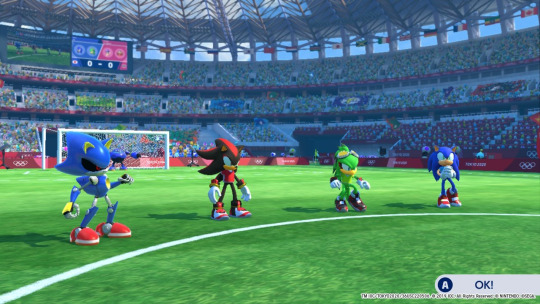
This game has a very interesting premise too. Since Tokyo was the host of the Olympics back in 1964, there is a time travel plot where Sonic, Eggman, Mario, Bowser, and Toad get sucked into a video game world based on those events. It allows for a fresh idea presented with classic sprites of these beloved characters. With the 2020 Olympic events combined with the 1964 events, there are plenty of events to try out.
I’d be remiss if I didn’t describe how nice the game looks. Mario & Sonic at the Olympic Games Tokyo 2020 is a very good looking game. In single player, the game constantly runs at 60FPS with highly detailed character models and lush environments. The crowds consisting of Toads, Shy Guys, Flickies, and more are still 2D textures that are animated well, but when inspected, they do not hold up. In Olympic events where the game is handled in splitscreen, the framerate can often take a hit. It’s nothing unplayable, but it is very noticeable. The menus are also very slick though a bit simplistic from past entries. Even so, you’ll be treated with wonderful character renders over the backdrop of various Tokyo locales. The only problem with the visuals come from the retro 1964 mode. While the sprites look fine, there is a huge clash between the Super Mario characters being 8-bit sprites while the Sonic characters are 16-bit sprites. It seems as this was done for broad appeal since Mario’s NES outings and Sonic’s Genesis outings are arguably their most well-known appearances. Even so, it doesn’t mesh together perfectly.
So the game looks good for the most part, but how does it sound? Honestly, it’s a mixed bag and a particularly odd one too. During story mode, characters do not speak in full sentences. Sonic may say “Hey” while the text box fills in an entire sentence of dialogue. This isn’t a problem, but what is a bit distracting are the voice samples chosen; specifically, the Super Mario characters. Mario and Luigi have no text boxes with their dialogue, but instead will only make small noises or words. It becomes increasingly annoying as their responses are so limited. You cannot skip or fast forward any dialogue boxes or animations either. There was no reason to keep them from talking as Bowser, Princess Peach, and Toad all talk just as the Sonic characters do. However, characters like Luigi, Daisy, and the Koopalings have the most peculiar voice samples. Daisy sounds like she’s about to cough up her lunch and the Koopalings have this odd reverb effect that sounds like a rendering error. Many of these samples just sound unpleasant and you’ll be hearing them enough that it becomes grating.
Now, the Mario & Sonic series has been praised by fans for their amazing remixes of classic songs. These remixes allowed some unique flair to be given to countless songs from Mario and Sonic’s catalogue. So, one may wonder how many remixes there are in Mario & Sonic Tokyo. Two. There are only two remixes from the respective series. Sonic’s side received a rather standard and unimpressive remix of Metropolitan Highway from Sonic Forces. It doesn’t improve the original song at all and feels a bit half baked. On the other side, Mario received a remix of Peach’s Castle theme and it’s frankly awful. Just sped up with synth-like instruments. When this has been a repeated highlight for these games, (even in the less-than-stellar Wii U games), it’s baffling that SEGA and Nintendo didn’t try harder here. It feels lazy and extremely disappointing. In past games, you could go back to any event and change the standard background music to whatever songs you have unlocked. It’s just not possible here. That means that during the events, you’ll be listening to original music. Thankfully, it’s mostly very good! I am a big fan of the tunes set to Rugby Sevens, a battle with Metal Sonic, Surfing, and Dream Shooting. A lot of the music has a Japanese flair to it and it’s very well composed. Some songs are extremely catchy and I’ve found myself remembering and humming them outside of my time with the game. However, during the lengthy story cutscenes, you may be cycling through the same 5 or 6 songs and it can become old very quickly. They are good songs, but even the retro music wears thin when it’s been playing for most of your downtime.
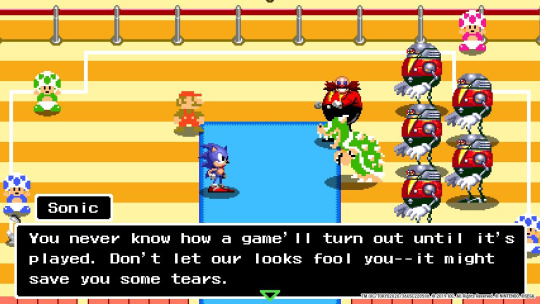
Sonic fans have always been passionate about the voice work of the Sonic the Hedgehog series. Thankfully, the new voice clips (during events) are pretty good. Characters have interesting remarks when winning and some of them speak perfectly to their established characters. I believe that for the Sonic characters, most if not all of the voice clips are new. There are some baffling ones like Sonic saying “Ole!” and “Right through that wall!” at the most random times. Characters like Tails and Vector are very endearing in this game. Even so, it works well and as a fan, it was fun to hear. The Mario characters definitely have some new voice clips, but it’s hard to tell when their characters don’t vocally emote as often outside of this game. I’m sure there are some repeated clips, but there not all reused.
As this is a minigame collection, it’s important to question how the game actually plays. Overall, I think the Olympic events have been reworked in a significant enough way that it feels rewarding… though not perfect. For example, the 100M race, skateboarding, and badminton are a few events that are just too simplistic for their own good. They are just not as fulfilling to play through as other events. Rugby sevens, soccer (which is strangely called Football despite the fact that Japan calls the sport soccer), Karate, Archery, Sport Climbing, and Equestrian are a few of the events that are just exhilarating. Most of the events have done an admirable job allowing for motion controls with two joy cons, one joy con, or buttons. Since I have been gaming since the early 1990s, I almost always prefer button controls. Even so, I have to admit that the motion controls are fun… for some of the events. Archery is a blast with motion controls, as are the track & field events. The game seems to make a conscious effort to balance the less accurate use of motion controls to button controls. That’s great, but it can make some events feel unfairly difficult due to the handicap. For example, when using button controls, the Boxing event feels almost impossible to win without a huge amount of luck. If you’re knocked down while using buttons, you have to jam the A button to get up and it feels nearly impossible to recover within the allotted time. It’s something that was so aggravating that I found myself praying that SEGA would release a quality of life patch for this game to iron out some of the problems.
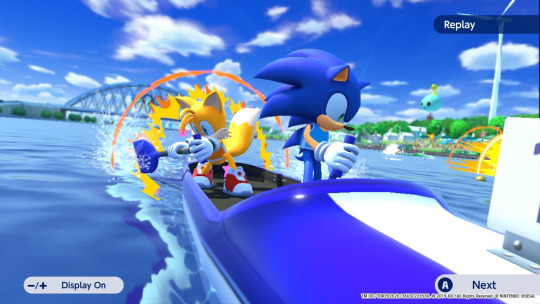
The 1964 events are pretty different from the 2020 events. Since they’re based on retro video games, they only allow for button controls. But with this aesthetic comes simplified gameplay. I found these events to be fun, but not too engaging. Shooting, 10M Platform, Marathon were pretty fun, but I wasn’t wowed by these. It’s 2019 and I think I can speak for many when I say that using retro sprites in your game doesn’t excite people as much as it used to. It sometimes comes across as desperate fan service. While these events are fun, I have to question: Has the game really benefited from going with this throwback? It has certainly increased the amount of events and didn’t hurt the overall package, but I also wasn’t blown away by their inclusion. Speaking of these retro events, it’s very saddening that it’s only limited to 8 characters. Classic characters like Donkey Kong, Metal Sonic, and especially Amy Rose are left out for seemingly no reason. This kind of exclusivity from the “classic” side of Sonic has been limited to Sonic, Tails, Knuckles, and Dr. Eggman for a long while now and it seems to ignore that Amy was part of that original crew too. Moreover, I’m sure fans would have loved to see more characters in this retro style. If SEGA/Nintendo had made more of an effort, we could have possibly seen more modern characters like Shadow the Hedgehog or Waluigi.
Throughout story mode there are also a number of mini games. In 2020, Luigi and Tails partake in many events. Whether it’s climbing up the side of Tokyo Tower, battling Shy Guys, or kicking a rugby ball to attack Metal Sonic; these events share their DNA with the normal Olympic events. Some of the ideas are creative, but they are over before they really begin. Again, they’re simplistic and through that simplicity is their downfall. I love the ideas on display, but I want them to be more engaging. One particular mini game that I was fond of has you searching for a particular Toad at the famous Shibuya Scramble. It’s basically a virtual version of a Where’s Waldo game, but it’s very fun and unique. The only problem is that it ends after finding three targets. If there was an option for this to be expanded into an endurance mode, then I think it would really have some legs.
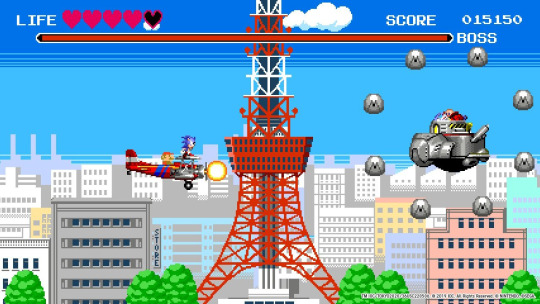
The mini games for the 1964 world are a bit more unique, but are still overly simple. You might be sneaking into a museum, using Sonic’s speed to chase down a bullet train (shinkansen), or even using the biplane known as the Tornado to attack Eggman’s mechs above Tokyo. Interestingly, that sky battle is the most complex of all the mini games, but even it ends after three stages. What works so well with this mode is that the stage consists of numerous Sonic enemies with decent fan service throughout. You’ll battle Eggman’s first boss from Sonic the Hedgehog 1 as well as Mecha Sonic and the Metropolis Zone boss from Sonic 2. It’s so bizarre that this great amount of fan service is so hidden. You must re-enter this game a second time from a completely different menu to see this.
There are three Dream Events in this game. The first being Dream Racing which is honestly fantastic. It’s based on a stage from Sonic Forces and features a downhill race on hoverboards with Mario Kart-like items. It’s a bit clunky on certain parts, but it’s a lot of fun. The kinetic energy of the whole thing makes me want more than just one stage based on this. It’s definitely a highlight and if there was entire game based on a more refined version of this... I wouldn’t be opposed. Following that is Dream Karate based on the Mushroom Kingdom from Super Mario Odyssey. It’s a mess. There doesn’t seem to be any clear strategy and it favors chaos over defined goals. Also, it hardly uses the Mario universe. It’s just a square arena set in a Mario world with a bad remix in the background. Very disappointing. Lastly is Dream Shooting which takes place in a Japanese temple with each corner of the temple representing a different season. It uses the gyro controls of the Nintendo Switch and it’s very fun. A little clunky here and there, but enjoyable nonetheless. It has one crucial flaw in the fact that your character will laugh every single time they hit a target. It gets annoying quick when you’re constantly firing away and hearing them cackle nonstop. I don’t know how that sort of thing still gets by developers.
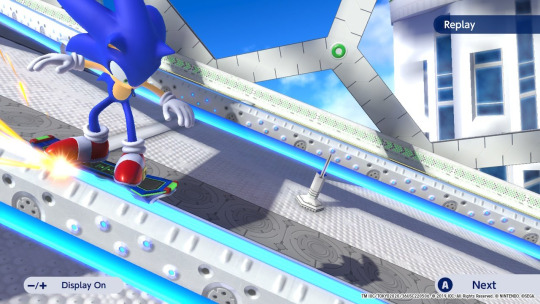
The story mode was heavily pushed with a lot of the promotion for this game. I can honestly say that this is not the type of game that needs a story, but it’s the kind of dopey thing that I am absolutely on board for. I was hoping for an over-the-top plot that had these characters doing ridiculous things based on idea from the Olympics. My expectations weren’t completely baseless either. Past games on the Nintendo DS and Nintendo 3DS have had story campaigns and they got wild with shadow clones of the characters to Dr. Eggman releasing giant robots. The games even featured some surprisingly well animated cutscenes too. You wouldn’t be wrong in thinking that I was hyped for this mode. What we got, however, was bare bones. I like the corny idea of the heroes and villains getting sucked into the retro game world. That’s wonderful, but unfortunately it doesn’t really get zanier than that. In 2020, Tails and Luigi work to save their friends by participating in regular Olympic events. In 1964, Mario and Sonic save themselves by participating in regular Olympic events. Yes, there are occasional mini games, but as I mentioned earlier, they are so simple and feel like they’ve finished before they’ve begun. Where’s the fun, the stupidly epic nature you can achieve when featuring franchises like Super Mario and Sonic the Hedgehog? Why can’t Eggman use the Gold Medals to make this fire monster that will compete against Mario and Sonic? Why can’t Metal Sonic cause chaos in Tokyo while Tails and Luigi stop him with a small platforming challenge? I know that there was an attempt with the mini games that are available, but it still comes up short and leaves me wanting a lot more.
This problem is completely related to the story as well. Meaning that while it has some genuinely great moments, it is a slog to get through at times. It has one formula and it follows that formula for the entire campaign. Every time, it’s a chore of: “go to this venue, talk to the character, face that character in an event, have them give you an item.” It never breaks off from this formula. Even the mini games follow the same structure. Again, where’s the heart? This is just running through the motions of a story. I’d love for it to really go wild with the Olympics and the characters at their disposal. One thing I couldn’t wrap my head around was the use of Luigi. This game really, really, really likes Luigi. He has the most mini games out of anybody, he’s featured in the story more than any other character, and once the game is finished, you are stuck using Luigi for any of the events within the epilogue. This includes the Dream Events too. Considering the fact that this game came out just one day after Luigi’s Mansion 3, I wouldn’t be surprised if this was intentional. It’s very odd that a game with Mario & Sonic in the title gives so much of the spotlight to Luigi. Along with his annoying vocal grunts that I mentioned earlier, I found Luigi got on my nerves throughout the story. The game also never lets you control any Sonic characters outside of a few events. Despite the fact that they are in pairs for the entire story, on the map screens, you can only control Mario in 1964 and Luigi in 2020. Not for nothing, but I’d like to control Sonic and Tails if I had the choice. This isn’t a huge complaint, but it’s something I noticed.
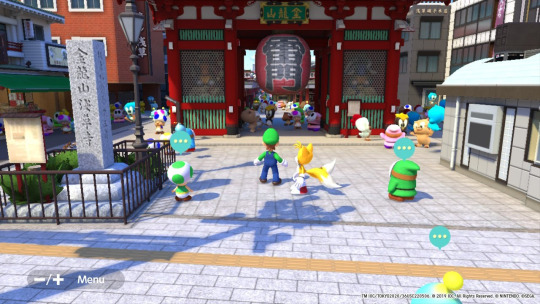
There are some positives to the story mode though. Certain character interactions are fantastic. I really loved bumping into Jet the Hawk, Wario & Waluigi, and Ludwig von Koopa during the campaign. Jet still refers to Sonic by his full name which was a bit of character consistency that made me smile. Sonic is also written pretty well. Since Mario doesn’t talk, Sonic does all of the talking for the heroes. He’s got a great mix of cockiness, heroism, and that cheesy factor that makes him so likeable. I was happy seeing how Sonic acted even if it wasn’t anything too mind blowing. Bowser and Eggman are written a bit more incompetent than usual, but it works well for comedic effect. There is also a moment in the climax that taps into that greatness I was hoping for. It’s a fantastic moment that I won’t spoil, but I enjoyed it and cared about what was happening to all of the character in the retro game world.
Throughout the map screens, you can find trivia pods. This seems like cheap filler, but I have to be honest… I actually found them very fun. There are 4 types of trivia cards: Olympic trivia, Japan trivia, Mario character trivia, and Sonic character trivia. I found myself learning a lot about the Olympics and Japan through this game. Often I became aware of things I never knew of. As a fan too, seeing Amy’s love for fortune reading or the game teasing that Wario and Waluigi are just two dudes who hang out together was a nice treat. However, being a big fan also means you know when they make mistakes. So when they say that Eggman Nega is Eggman’s descendant, I can’t help, but roll my eye. Yes, I know the Sonic Rivals games messed up the continuity, but the Sonic Rush games clearly established he’s from another dimension. His name is Eggman NEGA for crying out loud! In fact, his whole character is stated time and time again that he hates Eggman and yet he spends a vast majority of the campaign actively trying to save Eggman from the video game world. How many wires got crossed when they were making this game? Also, some pods say that Shadow being born on the Space Colony ARK is just a rumor... when we’ve had TWO games dedicated to that backstory. It just left me flabbergasted. Other trivia pods are just a waste of time though. “What color are Wendy’s shoes,” read one question that had a full body picture of Wendy attached to it. (Yes, you could clearly see her shoes). Were they that lazy with some of these?
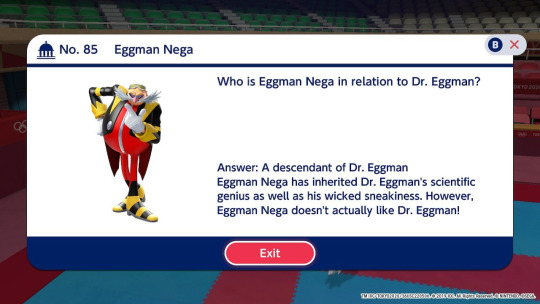
One particular thing about the story mode that had me laughing while also sighing was how much this game praises Japan. It’s honestly hilarious. Talking to Toads or animals around the map screens almost always has them saying how amazing Japan is, how the Olympics are this perfect accumulation of everybody’s efforts, or how nice and incredible Japanese achievements and citizens are. I’m not saying that Japan is a bad country, but when you’re constantly being told this stuff, after a while it just seems like excessive. I’m not blind to the fact that this game was made to be a commercial of sorts for the 2020 Olympic games and for Japan too, but the game clearly has more love and more of a desire to promote Japan than it does the two lead stars of the game. Let’s be honest here, Olympic fans aren’t coming out in droves to play this game, Mario and Sonic fans are.
Online play has been included too. Honestly, there isn’t too much to say about it. If you’ve played Super Smash Bros. Ultimate or Super Mario Maker 2 online before then you know what to expect. Nintendo’s shoddy online service doesn’t do Mario & Sonic any favors. It’s functional, but button delay and occasional lag are very apparent and do hamper the experience. I enjoyed a few games of Rugby Sevens online, but I never felt like I had as much control as I did when I was playing solo. For games like the Javelin Throw or Triple Jump that require pinpoint accuracy, I don’t see how this is going to be viable. Nintendo can make some great games, but they are constantly behind in all other aspects.
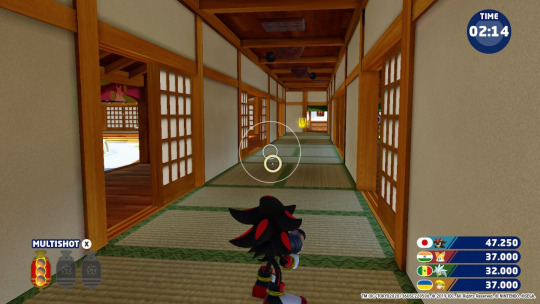
Plenty can be said about Mario & Sonic at the Olympic Games Tokyo 2020. Mechanically, all of the changes to the many events have benefited how they played. There’s a lot to experience here, but the game shies away from using the potential of having such iconic heroes in their line-up. I don’t know if it’s incompetence or laziness, but this doesn’t not reach the heights that it should. It has less Dream Events, less music remixes, less fan service, and a less ambitious story than previous Mario & Sonic games. Many people come into these games knowing they’ll be simple, but also feeling that the fan service and winks to the source material will elevate it into something great. Nevertheless, it feels like SEGA and Nintendo believed that putting Sonic and company in cute outfits would be enough to excuse other lackluster elements. I worry that this review may have come across as overly negative. There are many things I love about this game and I find that the game can be a real blast to play! The variety of the events and the pure fun factor of some cannot be denied. There are many good qualities to be found in this product, but when it lacks that special shine and polish that is to be expected by now, it inevitably feels disappointing. I don’t hate this game in the slightest, but I’d be lying if I said it I wasn’t left wanting more as a fan. SEGA and Nintendo are big companies and they can do better than this; we should expect more from them. At the end of the day, I will definitely be popping this game in from time to time. The mechanics are fun and there are lovable characters in here. I just wish they were celebrated more than the Olympics themselves.
13 notes
·
View notes
Text
Journal 4
Commenting on Tumblr’s release of top discussed mobile games in 2018 on their platform, Polygon pointed out that 3 of the top 5 were from small studios, marketed to women, and were in the genre of choose-your-own-adventure visual novels. Tumblr’s own user base might skew toward female users, so it is important to be skeptical about what these findings say about culture at large. However, I am interested in this supposed recent rise in popularity of visual novels as a research topic for this class, so I thought trying out these top 3 games might be a good place to start. As an aside, I need to sort out how the different terms I’ve seen floating around these games (visual novel, chose your own adventure, dating sim or game, otome) relate to and differ from each other.
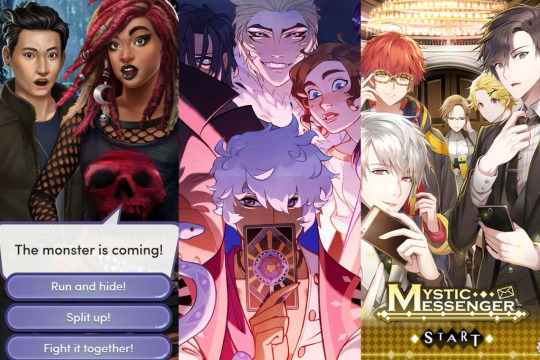
Top 3 visual novels on Tumblr in 2018. (source)
This week I played The Arcana (middle image above; story inspired by Tarot cards), which launched on Kickstarter in October 2016, and released in chapter increments beginning a few months later. Since April 2019, the game is currently releasing chapters for 3 new romance routes (now that the stories of the original 3 have ended). I played the prologue and began the romance route of the mysterious, emotionally unavailable character who I felt the prologue was most pushing you to be interested in. Once I moved past the prologue, I quickly found out that you can essentially only read 3 chapters every 3 hours. Perhaps this wasn’t an issue if you were following along as the game released. You could get excited and turn on the app once you saw an update notification. As a player arriving at this game several years later, hoping to get a general survey of the game over a condensed period of time, I felt viciously stymied and I never got very far romancing my brooding depressive nightmare boy. The overall problem was that I hadn’t found anything that hooked me into the story yet, making the waiting time turn into a total stopping point.
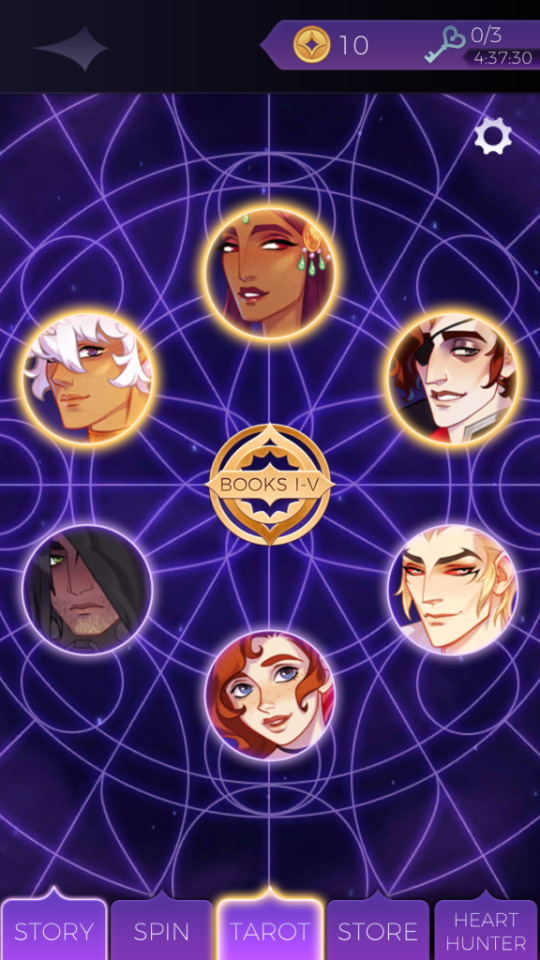
Arcana’s home screen, showing 6 different narrative paths. Minigames, features, and other monetizable parataxets available from the tabs at the bottom. (source)
Furthermore, the amount of paid options was egregious. Anytime someone dragged me somewhere, or I stumbled into a new room, yet again I would be forced to select (because I did not have enough coins, nor would I pay for more) some variant of, “oh never mind, I’m too tired,” as if I would ever willingly choose that option in a game…what I’m trying to say is, I believe they very purposefully made the free option seem as uninspiring as possible. It’s not really an option, it’s just a way to end the scene suddenly and rub in your face that you’re missing out on something. I am also not convinced that the paid options are just bonus material that’s not central to the story. It seemed like the most interesting potential plot developments had a paywall. What do you mean that after transporting unexpectedly through a magical fountain to see my romancee, all of a sudden I have to pay if I want to explore the mystical dream world he’s in with him instead of just going right back through the fountain to sleep? As a whole, playing this game was a very frustrating experience and the intrusion of monetization everywhere I turned made it unpleasant and deflating. How can you get excited when the game keeps trying to pry money from you?
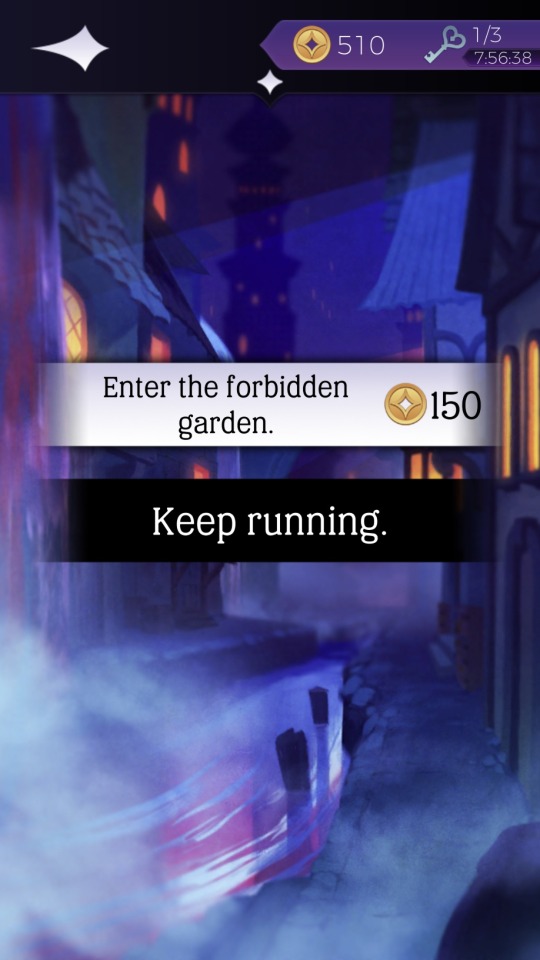
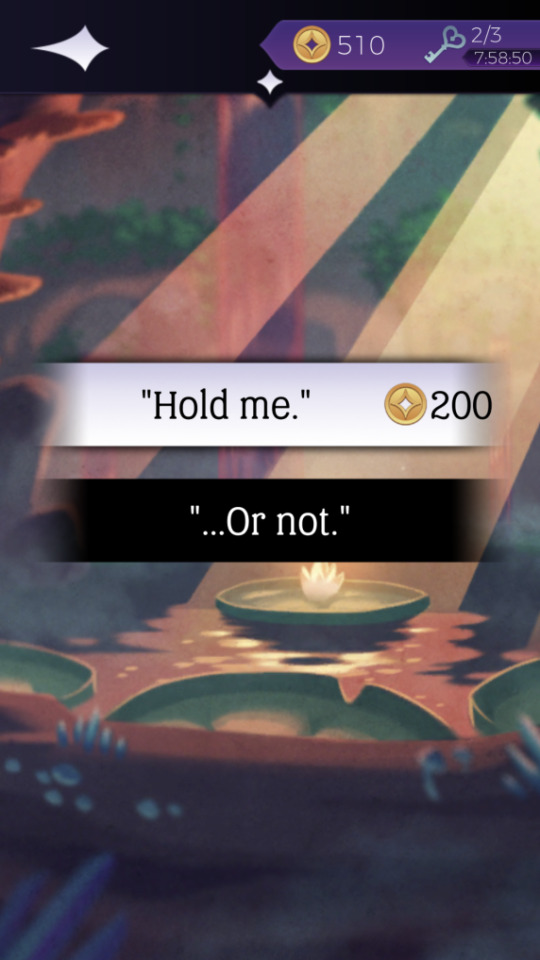
Examples of in-game monetization. (source)
A question I should perhaps have led with is whether Arcana and other games of the visual novel variety would be considered games at all in the conceptions of the readings this week. I did wonder what Frasca would make of this game. Simulation is a part of the name (dating sim) and this genre encourages players to keep trying out different choices so that they can collect all of the different possible endings. (In addition to having different character romance paths, Arcana also has two different endings for each character. Also, each character has a gallery section with black squares to be filled in once you discover them in the story. Other similar features encourage you to play over and over.) This exploratory format, where the player is an author of what happens, seems as though it would appeal to Frasca’s ideas about the possibilities and specificity of games compared to representational media. On the other hand, visual novel is an alternate name for these games and they have the qualities Frasca associates with ludus: a 3-part story structure, an Aristotelian ending with closure, a world that has simple definitions of good/bad, winner/loser. Though I cannot comment on a full story arc in the Arcana, the game has a very clear goal of seeing the story play out to its end. Frasca does however admit that games might have a ludus structure.
In Grodal’s work, I found a very apt description of why Arcana did not interest me as a game. Grodal writes that third-person stories in video games often fail because “In films and novels (third) persons are infused with the life and agency by authors and characters, and most readers and viewers will attribute that life to the characters, not to the ‘storyteller.’ In the video game, it is the job of the player to create ‘life’ in the third person, and failure to do so will create feelings of a mechanical lifelessness, eventually perceived as due to the designer and his or her system” (152). Beyond not feeling like my choices had an impact on the story, I could not really insert myself or a character I gave life to much in the story, which did give me a feeling of mechanical lifelessness as I jumped through the hoops of the narrative. I think for this genre of games to work for you, you need to be imagining the character; I didn’t and the narrative felt blank and unfulfilling. Meanwhile, fan reddit and tumblr accounts often make fan art of their insert character. The Polygon review also claims that being able to control the personal pronouns in use and add a character name added a lot of enjoyment to the experience. But it’s just not something I invested in. I wanted to experience the story in a third-person way.
I’m not sure I agree completely that games best describe a first-person perspective and first-person emotions, as Grodal lays it out. Grodal links exploring, fighting, sex, eating, and laughing to first-person, active experiences, and other emotions stemming from empathy, like pity and admiration to third-person, passive experiences. This seems problematic to me because I enjoy reading novels and experiencing the emotions of the characters second-hand, an (active!) experience Grodal also recognizes in watching movies. While I do not have proof, it seems wrong to say that video games cannot also function in this mode.
Finally, Grodal suggests that emotions related to sex are ideally suited to video games whereas Juul argues that games resist complex themes like love, because you cannot really implement them in the rules of the game. He disparages the connection between simple mechanical tasks and the love story in Myst. Meanwhile, Grodal leans in to the aesthetic of repetition in video games, how they mirror the gritty, repeated, procedural actions of everyday life. Whereas I agree with Juul on the one hand, that dating simulations might be a rigid representation of romantic relationships, I do definitely agree on the other hand with Grodal that a relationship functions like a task that requires a repeated set of interactions, moving from unfamiliarity and challenge, to mastery, to automation. There’s something about how games represent relationships that really rings true to real life. Or rather, dating sims make sense in their representation of fiction through rules.
0 notes